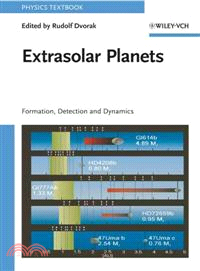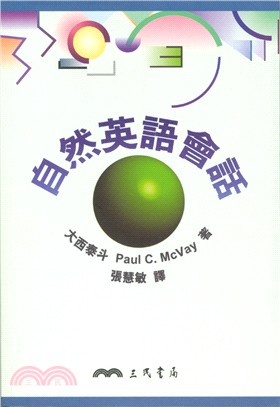EXTRASOLAR PLANETS - FORMATION, DETECTION AND DYNAMICS
商品資訊
商品簡介
Edited by a renowned expert in solar system dynamics with chapters written by the leading experts in the method describedfrom the US and Europethis is an ideal textbook for graduates, students in astronomy, and astronomers.
作者簡介
目次
List of Contributors.
1 Planetary Masses and Orbital Parameters from Radial Velocity Measurements (C. Beaugé, S. Ferraz-Mello, and T. A. Michtchenko).
1.1 Exoplanet Detection.
1.2 Radial Velocity in Astrocentric Elements.
1.3 Orbital Fits from Radial Velocity Curves.
1.3.1 Primary Parameters.
1.3.2 Secondary Parameters.
1.3.3 N-Body Fits.
1.4 Coordinate Systems and Equations of Motion.
1.4.1 Barycentric Hamiltonian Equations.
1.4.2 Jacobi Hamiltonian Formalism.
1.4.3 Poincaré Hamiltonian Formalism.
1.4.4 Generalized Orbital Elements and Delaunay Variables.
1.4.5 Comparisons Between Coordinate Systems.
1.4.6 The Conservation of the Angular Momentum.
2 Terrestrial Planets in Extrasolar Planetary Systems (R. Dvorak and E. Pilat-Lohinger).
2.1 Introduction.
2.2 The Methods of Investigation.
2.3 Basics of the Formation of Terrestrial Planets.
2.4 Stability Studies of Terrestrial Planets.
2.4.1 The G2 Systems and Gliese 777A.
2.4.2 Theoretical and Numerical Stability Investigation of the G4 and EPS HD108874.
2.5 A Global Approach: The Exocatalogue.
2.6 Terrestrial Planets in Multiplanetary Systems.
2.6.1 The Changing Story of HD74156.
2.7 Conclusions.
3 Mission Requirements: How to Search for Extrasolar Planets (M. Fridlund and L. Kaltenegger).
3.1 Introduction.
3.2 Formulation of the Problem and High-level Scientific Requirements.
3.3 Comparative Planetology.
3.4 Methods and the Need to go into Space.
3.5 Space Missions.
3.5.1 MOST – The First Step.
3.5.2 CoRoT – The First True Exoplanetary Mission.
3.5.3 Kepler – The Exploration Continues.
3.5.4 The Role of the Herschel Mission in the Search for Other Earths.
3.5.5 GAIA – The First Global Survey Instrument and the Cosmic Census.
3.5.6 SIM – Planet Quest.
3.6 Darwin and the Terrestrial Planet Finder(s) – OtherWorlds with Life as we Know it.
3.6.1 Nulling Interferometry.
3.6.2 Background and Foreground Flux.
3.6.3 Model of an Exosolar System.
3.7 The Future – Mission Accomplished?
4 Biomarkers Set in Context (L. Kaltenegger and F. Selsis).
4.1 Introduction.
4.2 Biomarkers.
4.3 Biomarker Signatures in DifferentWavelength Ranges.
4.4 Potential Biomarkers.
4.5 A Habitable Planet.
4.6 Oxygen and Ozone Production on Earth.
4.7 Cloud Features.
4.8 Biomarkers and their Evolution over Geological Times on Earth.
4.9 Planets around Different Stars.
4.10 Abiotic Sources.
4.11 Biomarkers Detection Set in Context.
4.11.1 Temperature and Radius of the Planets.
4.12 Orbital Flux Variations.
4.13 Summary.
5 The Formation of Resonant Planetary Systems (W. Kley and Z. Sándor).
5.1 The Solar System.
5.2 Extrasolar Systems in Mean-motion Resonance.
5.3 Planet–Disk Interaction.
5.4 Resonant Capture.
5.4.1 Hydrodynamical Studies.
5.4.2 Forced Migration.
5.4.3 Second Fundamental Model of Resonance.
5.4.4 Outcome of Resonant Encounters.
5.5 Specific Systems.
5.5.1 GJ 876: A Case of Adiabatic Migration.
5.5.2 Formation of Systems HD 128311 and HD 73526 through Mixed Scenarios.
5.6 Summary.
6 Impact of Stellar Activity on the Evolution of Planetary Atmospheres and Habitability (H. Lammer, M. L. Khodachenko, H. I. M. Lichtenegger, and Y. N. Kulikov).
6.1 Introduction.
6.2 The Habitable Zone Around Main-sequence Stars.
6.2.1 General Definition of the Habitable Zone.
6.2.2 The Circumstellar Habitable Zone.
6.2.3 Geophysical Factors which Influence Habitability.
6.2.4 Stellar Radiation and Particle Forcing.
6.3 The Impact of the Stellar Radiation on the Upper Atmosphere.
6.3.1 Heating, Cooling, and Expansion of the Upper Atmosphere.
6.3.2 Thermal Escape of Atmosphere andWater.
6.4 StellarWind and CME Plasma Interaction with Planetary Atmospheres.
6.4.1 Collision Probability Between Planets and CMEs.
6.4.2 Atmospheric Mass-loss Caused by CME Exposure.
6.5 Discussion.
7 Dynamics of the Extrasolar Planetary Systems (T. A. Michtchenko, S. Ferraz-Mello, and C. Beaugé).
7.1 Introduction.
7.2 Classification of the Systems with Respect to their Dynamical Behavior.
7.3 Numerical Integrations, Dynamical Maps and Modeling.
7.4 Secular Dynamics: υ Andromedae Planets c and d.
7.4.1 Planar Dynamics.
7.4.2 Dynamical Maps.
7.4.3 3D Dynamics.
7.4.4 Inclination and Planetary Mass Indetermination.
7.4.5 Proximity to Mean-motion Resonances.
7.5 Resonant Dynamics: Planetary Systems in Mean-Motion Resonances.
7.5.1 GJ 876 Planets c and b.
7.5.2 HD 82943 Planets c and b.
7.6 Nearly Resonant Systems with Small Eccentricities.
8 Planets in Double Stars (E. Pilat-Lohinger and R. Dvorak).
8.1 Introduction.
8.2 Computations and Methods.
8.3 General Stability Studies of Planetary Motion in Double-star Systems.
8.3.1 S-type Motion.
8.3.2 P-type Motion.
8.3.3 L-type Motion.
8.4 Application to Real Systems.
8.5 Influence of the Secondary.
8.6 Detected Planets in Binary Systems.
8.7 Summary.
9 The Transit Method (H. Rauer and A. Erikson).
9.1 Introduction.
9.2 Overview of Detected Transiting Planets.
9.2.1 From Predictions to Regular Detections.
9.2.2 Basic Parameters of the Known Transiting Planets.
9.3 The Transit Signal.
9.4 From Light Curves to Planets.
9.4.1 Transit Signal Detection.
9.4.2 Confirmation or Rejection.
9.5 Characterizing Factors of Transit Searches.
9.5.1 The Effective Duty Cycle.
9.5.2 Target Field Selection.
9.5.3 Noise Sources Affecting the Photometry.
9.6 Detection Probabilities.
9.7 Further Characterization of Transiting Planets.
9.8 Future Prospects.
10 US Programs and Space Missions for Extrasolar Planet Research (P. K. Seidelmann).
10.1 Introduction.
10.2 Kepler.
10.3 SIM PlanetQuest.
10.4 Terrestrial Planet Finder – Coronograph (TPF-C).
10.5 Terrestrial Planet Finder – Infrared (TPF-I).
10.6 Spitzer Space Telescope.
10.7 JamesWebb Space Telescope (JWST).
10.8 Microvariability and Oscillations of Stars (MOST).
10.9 Stratospheric Observatory for Infrared Astronomy (SOFIA).
10.10 Keck Interferometer.
10.11 Large Binocular Telescope Interferometer (LBTI).
10.12 Palomar Observatory.
10.13 Pan-STARRS.
10.14 Thirty Meter Class Telescopes.
10.15 Scientific Results.
10.16 Conclusions.
11 Habitable Zones in Extrasolar Planetary Systems (W. von Bloh, C. Bounama, and S. Franck).
11.1 Introduction.
11.2 Modeling the Earth System.
11.2.1 Planetary Climate.
11.2.2 The Global Carbon Cycle.
11.2.3 Silicate-RockWeathering Rate.
11.2.4 Biological Productivity.
11.2.5 Geodynamics.
11.3 The Habitable Zone in the Solar System.
11.4 Habitable Zone Around Main-sequence Stars.
11.5 Dynamic Habitability in Extrasolar Planetary Systems.
11.5.1 Orbital Stability.
11.5.2 Results for 86 Extrasolar Planetary Systems.
11.6 Summary.
Index.
主題書展
更多書展本週66折
您曾經瀏覽過的商品
購物須知
外文書商品之書封,為出版社提供之樣本。實際出貨商品,以出版社所提供之現有版本為主。部份書籍,因出版社供應狀況特殊,匯率將依實際狀況做調整。
無庫存之商品,在您完成訂單程序之後,將以空運的方式為你下單調貨。為了縮短等待的時間,建議您將外文書與其他商品分開下單,以獲得最快的取貨速度,平均調貨時間為1~2個月。
為了保護您的權益,「三民網路書店」提供會員七日商品鑑賞期(收到商品為起始日)。
若要辦理退貨,請在商品鑑賞期內寄回,且商品必須是全新狀態與完整包裝(商品、附件、發票、隨貨贈品等)否則恕不接受退貨。























